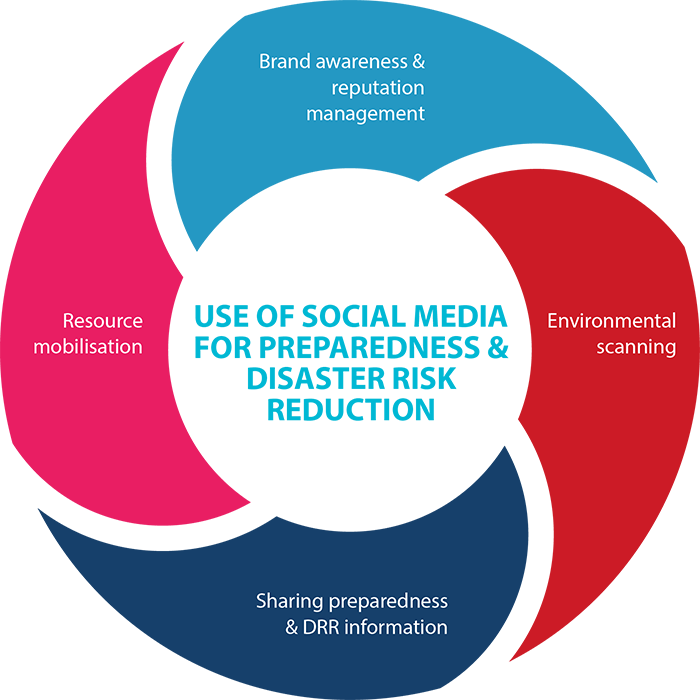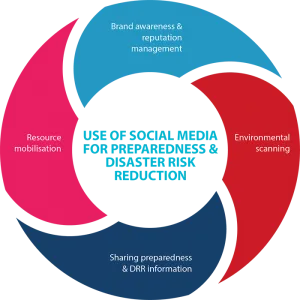PREP1: Domain Requirements


During April and May 2017, we conducted semi-structured interviews and a small-scale online survey with representatives from across the Red Cross Red Crescent (RCRC) network. In our latest blog post, we will be highlighting the core findings surrounding the domain requirements for the use of a social media analysis tool for disaster preparedness and disaster risk reduction efforts.
During the collection of domain requirements, we were particularly interested in understanding what social media (SM) was being used, and what for. In total, four clear types of use were identified:
i. Brand awareness and reputation management for RCRC societies
SM is commonly used for profiling and positioning the brand of national societies. SM provides RCRC organisations with an opportunity to inform their communities about who they are and what they do. This may include raising awareness of the typical services that the organisation offers (e.g. event support and first aid training). At a regional and global level, the IFRC secretariat reinforces the brand of national societies and their key messages. For instance, IFRC Americas commonly retweet posts by their regional national societies. Not only does this further promote the national society, but it is also important for relationship building between IFRC Americas and national societies. Elsewhere, the EU Red Cross office uses its position to highlight the activities of European national societies to influential bodies and policy-makers (e.g. the European Commission). Within this context, SM can be used for both one-way and two-way communication purposes. For instance, one-way communication can be used to push messages about the society’s activities. Alternatively, two-way communication can be used to answer questions, and counter misconceptions that some individuals may hold.
ii. Environmental scanning
An important role of social media is its use as a channel for monitoring and listening to what others are saying, thereby informing RCRC understanding of unfolding situations and crises. Such a use is seen as fundamental by IFRC Geneva, and is something that they are actively supporting national societies with (e.g., via training activities). In this manner, SM is an important medium for improving situational awareness and can even go so far as to act as a form of risk identification and early warning. For instance, while it remains important to verify any information identified on SM, by monitoring specific keywords and/or hashtags it may be possible for national societies to understand whether there is any danger of an imminent flood. The Kenya Red Cross, for instance monitor any information relating to traffic incidents and/or protests thereby being able to inform their audiences of potential areas to avoid. Furthermore, in the event of a crisis unfolding, it may also be possible for national societies to identify rumours and counter these rumours, thereby directly countering the spread of misinformation. Lastly, SM can be used to monitor what other reputable organisations are saying, and thus to identify any important information (e.g. a potential risk) coming from others. A final point of consideration in terms of environmental scanning is the monitoring of SM platform related updates (e.g., updates to the way direct messages and location information works on Twitter (Lüge, 2017) that may help improve RCRC use of SM in the event of preparing for or indeed responding or recovering from a crisis.
iii. Sharing disaster preparedness and disaster risk reduction information
On a more general level, SM can be used as a form of one-way communication for sharing context-specific disaster preparedness and disaster risk reduction information. Such a measure can be used for long-term preparedness activities (e.g. ongoing earthquake preparedness activities in California), as well as for short-term preparedness activities (e.g. storm warnings and the importance of flood defences and other awareness raising activities). This is particularly important for raising awareness of measures that individuals and organisations can take to improve their own resilience to potential crises.
For instance, in the event of a heat wave, the Austrian Red Cross use pre-prepared messages to schedule messages to help prepare people for known risks. By doing so, in a heat wave for instance they can inform people how to cope with changes in temperature (e.g. staying hydrated), as well as how to support their wider social networks (particularly vulnerable persons such as the elderly). SM is a channel for communicating safety advice, as well as engaging individuals and organisations to care for their wider communities. Elsewhere, in the lead-up to an impending or ongoing crisis such as a Cyclone, SM can and has been used to share key messages. For instance, in the lead-up and during the events of Cyclone Debbie in April 2017, the Australian Red Cross recently posted information about weather updates, the availability of shelters, advice on coping and clean-up advice. It may also be useful to share organisation-based messages (e.g. standard operational procedures).
iv. Resource mobilisation
A common use of SM by national societies, is to mobilise resources. Resources may include: financial aid, clothing, food among others. This is a key role that communication teams are commonly involved with and thus ought to be measuring engagement to understand the reach and impact of their messages. For instance, the Kenya Red Cross are routinely requested by local hospitals to request blood donations. Others, may be involved in supporting the gathering of financial aid for ongoing crises (e.g. the Syrian Crisis).
Next Steps:
Over the course of June we will be working on further refining the system specification and core functionality of PREP 1, along with a virtual workshop with representatives in the study to support us in validating and prioritising the core features of the tool.
Find out more: To find out more see Trilateral's project page, from here you can find links to their website (and sign up to their newsletter), and you can find links to the Global Disaster Preparedness website (which has a resource library on social media).
Stay updated
Sign up for our newsletter to receive regular updates on resources, news, and insights like this. Don’t miss out on important information that can help you stay informed and engaged.
Related articles
.png)


Explore Elrha
Learn more about our mission, the organisations we support, and the resources we provide to drive research and innovation in humanitarian response.